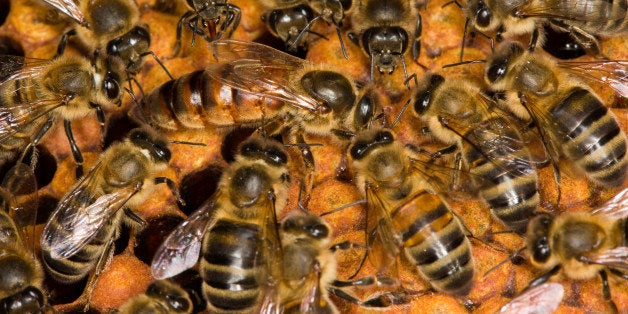
By Francie Diep(Click here for original article.)
What's killing the bees? If you've been watching the news, you might answer: "Colony collapse disorder." Yet after the winter of 2011-2012, beekeepers only attributed 8 percent of their wintertime honeybee-hive losses to colony collapse disorder. Other reasons for hive deaths were much more common, including ailing queen bees, to which beekeepers attributed 32 percent of their dead hives.
At one recent pollination research conference, nobody seemed to be looking for the disorder's cause anymore. "Yes, we have pretty much transitioned from a discussion of CCD to a discussion of honey bee health," says Christina Grozinger, a Pennsylvania State University entomologist and one of the organizers of the 2013 International Conference on Pollinator Biology, Health and Policy, held at Penn State in August.
In fact, some entomologists say colony collapse disorder is no longer a major problem. After a spike in incidents in 2006, when the condition was first described, cases dwindled. American honeybee colonies are still dying at an average rate of 30 percent every year, but most hives succumb to the same problems that have plagued beekeepers since 1990 or even 1890: bees running out of honey to eat over the winter, the blood-sucking Varroa mite, and unhealthy queens.
So far, U.S. beekeepers have replaced the hives they've lost, so the nation is not running out of bees. However, starting new hives is costly and difficult and stresses bees. Experts worry that if honeybees' troubles continue, one day there won't be enough bees to pollinate foods such as almonds, apples, broccoli and even lettuce.
As colony collapse disorder cases have declined, researchers have turned to try and understand the more common causes of ill health in bees. Some of the most recent research examines what may be affecting queen bees—and how to breed more robust ones.
Queens just don't seem as long-lived and fecund as they used to be, says David Tarpy, who researches beekeeping at the University of North Carolina. Sometimes worker bees even kill their own queens. This behavior, called supersedure, is part of a healthy colony's life cycle, but beekeepers say they're seeing it occur at an accelerated rate, which stresses hives.
"It just seems to be getting worse and worse every year," Tarpy says, "but there's nothing really obvious we can point to as a reason."
Tarpy and others have found some early hints. Early-stage studies have implicated both pesticides for crops and for bees, in the form of treatments for Varroa mites. However, there's no evidence yet directly linking miticides to high-rate queen-killing. Plus, keeping colonies free of Varroa mites helps their health.
Reed Johnson, an entomologist at Ohio State University, found that exposure to a common combination of an insecticide, diflubenzuron, and a fungicide, propiconazole, increased the number of queens that die as larva in their little honeycomb cells. He presented his results at Penn State.
However, his findings are limited to queen bees reared near almond orchards where these pesticides are used, he warns. Queen health problems also occur in areas where people breed queens but do not grow almonds. "I've got this one little story that I think is definitely an issue," he says. "I don't know if I can really answer the larger issue, which is why queens just don't last."
Meanwhile, Tarpy found queen bees that spent their larval days in beeswax that was contaminated with a combination of two popular miticides, coumaphos and fluvalinate, had fewer live sperm. A queen bee only mates one day, soon after she matures. The sperm she gets that day is supposed to last her the rest of her life. In healthy supersedure, her workers kill her when she's two or three years old, at which age she's running out of sperm.
Without enough sperm for fertilized eggs, a colony would die as the sterile workers died. Workers only live a few months.
Tarpy and his colleagues found miticide-exposed queens had significantly fewer live sperm than unexposed queens. Yet they also found miticide-treated hives had more honeycomb cells devoted to larva than untreated hives.
"I don't really know what to make of that result," Juliana Rangel, formerly a post-doctoral researcher in Tarpy's lab and now an assistant professor at Texas A&M, said during the Penn State conference.
"I think we have known for a long time that miticides can adversely affect queens and kill drone sperm," says Dennis vanEngelsdorp, an entomologist at the University of Maryland who was one of the first to identify colony collapse disorder. "It's like chemotherapy. They know it's bad, but it's a lot better than the alternative."
For now, Tarpy's best advice for beekeepers is to stay vigilant and replace queens at the first sign of trouble. Better ideas to protect hives may already be on the way. Tarpy runs a program that trains beekeepers to raise their own queens, instead of mail-ordering them from California or Florida, which is the usual practice. Locally raised queens could be better adapted to their environments and are genetically different from their long-distance cousins, adding some much needed diversity to the gene pool. Meanwhile, vanEngelsdorp is working with breeders to create bees that are resistant to Varroa mites and other bee illnesses, without the need for pesticides.
